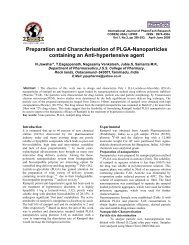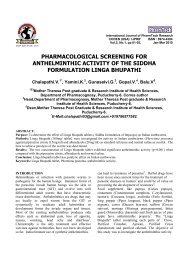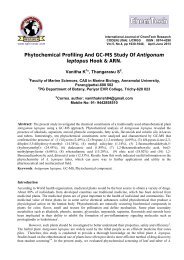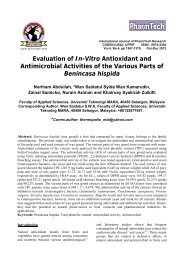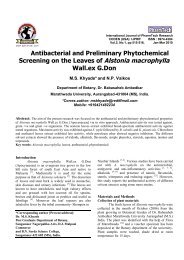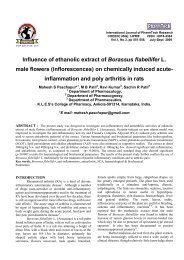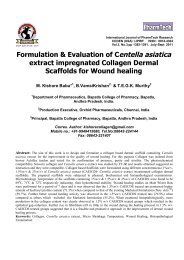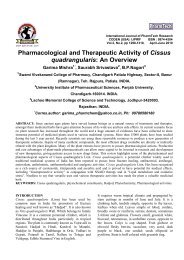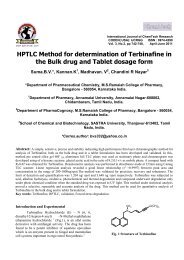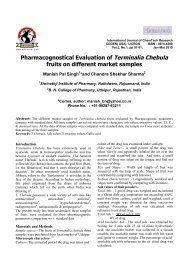Poly Electrolyte Complex of Chitosan Alginate for Local Drug Delivery
Poly Electrolyte Complex of Chitosan Alginate for Local Drug Delivery
Poly Electrolyte Complex of Chitosan Alginate for Local Drug Delivery
Create successful ePaper yourself
Turn your PDF publications into a flip-book with our unique Google optimized e-Paper software.
Bhupendra G. Prajapati et al /Int.J. ChemTech Res.2009,1(3) 644<br />
rapid agitation. After this, the viscous polymeric<br />
coacervate was obtained to which propylene glycol was<br />
added as plasticizer. Accurately weighed quantity <strong>of</strong> drug,<br />
clotrimazole was added and stirred gently <strong>for</strong> 2 min to get<br />
uni<strong>for</strong>m dispersion. The resultant coacervate gel was kept<br />
a side <strong>for</strong> sometime to remove air bubble and then it was<br />
casted into plastic petri dish <strong>of</strong> 5 cm diameter. Petri dish<br />
was kept into vacuum oven at 60 0 C <strong>for</strong> 24 hours drying.<br />
The completely dry film was stored in airtight container<br />
at room temperature.<br />
Formulation Conditions<br />
To get fine and uni<strong>for</strong>m coacervate <strong>of</strong> chitosan-alginate,<br />
various process parameters like type <strong>of</strong> water miscible<br />
solvent addition, stirrer, speed <strong>of</strong> stirrer, time <strong>of</strong> reaction,<br />
temperature <strong>of</strong> drying, drying time, concentration <strong>of</strong><br />
plasticizer, chitosan-alginate ration and drug to polymer<br />
ration were optimized based on quality <strong>of</strong> the complex<br />
coacervates obtained.<br />
Various batches <strong>of</strong> complex coacervate were prepared by<br />
varying the parameters under study, like <strong>for</strong> selection <strong>of</strong><br />
stirrer coacervates were prepared using both magnetic<br />
and three-blade stirrer. For selection <strong>of</strong> speed <strong>of</strong> batches<br />
were prepared at high (4000), medium (2000) and low<br />
(1000) speeds. Three batches were reacted <strong>for</strong> different<br />
time <strong>of</strong> 10, 20 and 30 min. Drying time and temperature<br />
was optimized by taking drying three batches at room<br />
temperature, at 60 0 C and at 70 0 C respectively. Different<br />
concentration <strong>of</strong> propylene glycol as plasticizer was<br />
studied i.e. 0.3%, 0.5% and 0.7%. Finally batches <strong>of</strong><br />
films were prepared with different ratio <strong>of</strong> chitosan to<br />
alginate i.e. 1:1, 1:1.5, 1:2 and 2:1. Viscosity <strong>of</strong> the<br />
supernatant obtained after complexatoin <strong>of</strong> two polymers<br />
in different ratio was measured. Films prepared <strong>of</strong><br />
different ratio <strong>of</strong> polymer were studied <strong>for</strong> swelling<br />
behaviors. <strong>Poly</strong>mer-To-<strong>Poly</strong>mer Ratio<br />
This work was carried out with four different ratio <strong>of</strong><br />
chitosan: alginate (1:1,1:1.5,1:2 and 2:1). The prepared<br />
polyelectrolyte films were evaluated <strong>for</strong> supernatant<br />
viscosity data and swelling index.<br />
<strong>Poly</strong>mer To <strong>Drug</strong> Ratio<br />
The polyelectrolyte film were prepared using four<br />
different ratio <strong>of</strong> polymer to clotrimazole powder (1.:<br />
2,1:2, 1:3 and 1:4) and evaluated <strong>for</strong> swelling index and<br />
invitro drug diffusion.<br />
Evaluation <strong>of</strong> Film<br />
Swelling Index 11<br />
Weighed pieces 1x1 cm 2 <strong>of</strong> film were immersed in<br />
distilled water; at 0.5, 1, 2, 4, 8 and 24 hours. Soaked<br />
films were removed from the medium at predetermined<br />
time, blotted to remove excess liquid and weighed<br />
immediately. The swelling index was calculated from the<br />
weight increase, as follows:<br />
Where W1and W2 are the weight <strong>of</strong> the film be<strong>for</strong>e and<br />
after immersion in the medium, respectively.<br />
Tensile Strength 10<br />
The mechanical properties <strong>of</strong> chitosan alginate films were<br />
evaluated using a texture analyzer (Instron Universal<br />
Model) equipped with a 500 gm load cell. Film strip in<br />
10 mm X 10 mm <strong>of</strong> dimension and free from air bubbles<br />
or physical imperfections, was held between two clamps<br />
positioned at a distance <strong>of</strong> 1 cm. During measurement,<br />
the film was pulled by top clamp at a rate <strong>of</strong><br />
10mm/minutes. The <strong>for</strong>ce and elongation were measured<br />
when the films broke. Measurements were run four times<br />
<strong>for</strong> each film. The tensile strength and elongation at break<br />
were calculated as below:<br />
Tensile strength (kg/mm 2 ) = Breaking <strong>for</strong>ce (kg)/Crosssectional<br />
area <strong>of</strong> sample (mm 2 )<br />
Elongation at break (%) = Increase in length at breaking<br />
point (mm)/Original length (mm) x100%<br />
Content Uni<strong>for</strong>mity<br />
To ensure uni<strong>for</strong>m distribution <strong>of</strong> clotrimazole in film, a<br />
content uni<strong>for</strong>mity test was per<strong>for</strong>med. Sample represent<br />
different regions within film <strong>of</strong> 1X1 cm 2 section <strong>of</strong> the<br />
optimized chitosan alginate film were cut from four<br />
different locations and were crushed and dipped to<br />
solvent system <strong>of</strong> 9:1 <strong>of</strong> acetate buffer and PEG 400 <strong>for</strong><br />
24 hours at room temperature. Content was filter out and<br />
filtrate was analyzed <strong>for</strong> drug content by UV<br />
spectrophotometrically.<br />
Content Uni<strong>for</strong>mity=<br />
= Actual amount <strong>of</strong> drug in film X 100<br />
Theoretical amount <strong>of</strong> drug<br />
present in film<br />
In Vitro <strong>Drug</strong> Diffusion 11<br />
In vitro drug diffusion, from chitosan alginate film was<br />
studied using modified franz diffusion cell with 2.52 cm2<br />
diffusion area and 20ml receptor volume. 1:9 ratio <strong>of</strong><br />
PEG 400 to acetate buffer (pH 5) was used to maintain<br />
sink conditions in the receptor compartment. Human<br />
cadaver skin was used as diffusion membrane. At<br />
different time interval aliquots were withdrawn and<br />
replaced with fresh buffer. Absorbance was measured.<br />
Comparative diffusion studies<br />
For comparative diffusion studies diffusion <strong>of</strong> final film<br />
containing drug to polymer ratio <strong>of</strong> 1:4 and cream base<br />
marketed <strong>for</strong>mulation was carried out using Franz<br />
diffusion cell. Accurately weighed quantity <strong>of</strong> cream that<br />
was equivalent to drug contained in diffusion area <strong>of</strong> film<br />
was taken <strong>for</strong> study.<br />
For this rat skin was used as membrane. Male S D Rat<br />
was anesthetized and an area <strong>of</strong> 3 cm2 was clean shaved<br />
on dorsal side. Skin was carefully cut and washed with<br />
phosphate buffer pH-7.4 be<strong>for</strong>e use.<br />
Result and discussion<br />
Preparation <strong>of</strong> Film<br />
For preparation <strong>of</strong> good film, it is desirable that the<br />
polyelectrolyte complex coacervate suspension, which is



